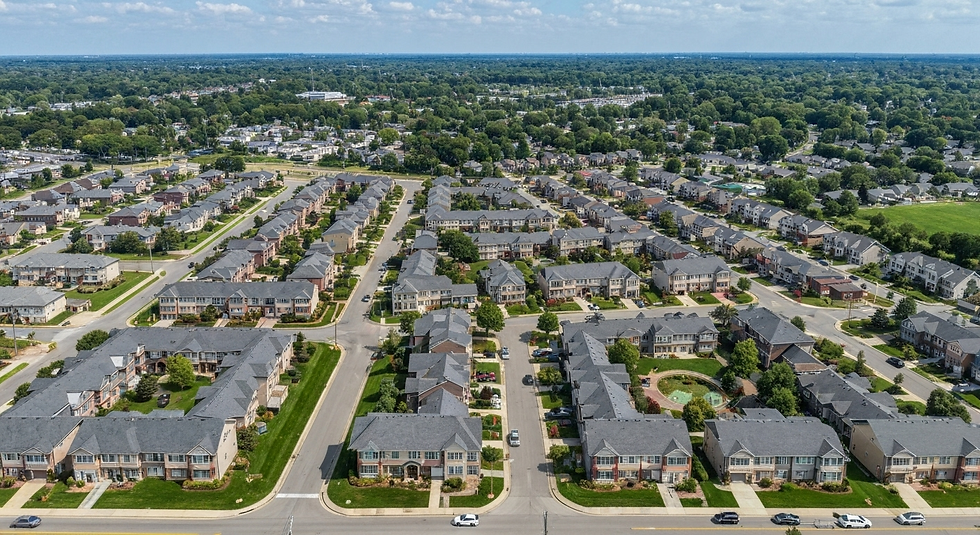The McMansion problem: Examining the Impact of Zoning Laws on American Communities
- Dennis Asis

- Sep 8
- 4 min read

The term "McMansion" evokes images of sprawling, extravagant homes that dominate American suburbs. Over the past few decades, these large, cookie-cutter houses have become a staple in many neighborhoods. Often criticized for their style and environmental footprint, the rise of McMansions is closely tied to zoning laws that dictate land use. In this post, we’ll uncover how these regulations are reshaping our communities and what it means for the future of American housing.
Understanding Zoning Laws
Zoning laws are regulations that govern how land can be used in different areas. They dictate everything from the construction types allowed to the density of housing. Though zoning laws aim to promote orderly development and protect property values, they can unintentionally create issues.
One significant outcome of these laws is the focus on single-family homes, often limiting more varied housing options. For example, residential land in many suburban areas is restricted to single-family homes. This leads to a lack of affordable housing, driving up demand for single-family homes and boosting the popularity of McMansions.

The Rise of McMansion problem
The trend of McMansions began in the 1980s and has firmly established itself in suburban landscapes. Such homes usually exceed 3,000 square feet and feature multiple garages, grand entryways, and expansive windows. While they cater to certain buyers, the average price for a McMansion can reach up to $1 million or more, often contributing to socioeconomic divides within the community.
Additionally, McMansions are energy-intensive and require substantial resources for heating and cooling. For instance, larger homes can use up to three times more energy than smaller ones. The construction of these homes often leads to the loss of green spaces, negatively impacting local ecosystems and increasing carbon emissions. McMansion problem

The Social Implications
The social effects of McMansions extend beyond their environmental impact. The preference for single-family homes can lead to uniform neighborhoods that lack diversity. Neighborhoods characterized by homogeneity foster isolation, causing residents to feel disconnected from one another.
Moreover, rising housing prices price out many families. As income disparities grow, individuals find themselves commuting longer distances to work. Workers commute more than 30 minutes each way—and this number is likely higher in areas with booming McMansion developments. Such long commutes put additional strain on transportation networks and contribute to environmental pollution.

The Role of Local Governments
Local governments are pivotal in shaping zoning laws and transforming the housing landscape. Many municipalities have not updated their regulations to match community needs. For example, some areas still enforce outdated codes that hinder the development of affordable multi-family units or mixed-use housing.
Ban on duplexes and triplexes, can do an inclusive housing policies. By promoting higher-density developments, local governments can create vibrant and diverse communities that cater to a range of residents.

Community Responses
As the McMansion crisis becomes more apparent, communities are mobilizing to address it. Grassroots organizations and neighborhood groups are advocating for zoning law reforms that enable sustainable and inclusive development which encourages more housing construction to meet the needs of growing populations.
Some communities are implementing local initiatives aimed at fostering sustainability. Neighborhoods shall craft policies that require new developments to include green spaces or community amenities. These changes not only encourage resident interaction but also enhance the overall quality of life.

The Future of American Housing
The future of American housing hinges on communities and local governments addressing the challenges posed by McMansions and outdated zoning laws. As the demand for affordable housing rises, it's crucial to balance preserving neighborhood character with accommodating population growth.
Creative solutions like co-housing, tiny homes, and mixed-use developments could offer viable paths forward. By embracing diverse living options, communities can promote inclusivity and better serve their residents' varied needs.

Looking Ahead
The McMansion crisis reveals the significant effects of zoning laws on American communities. While these regulations aim to foster orderly development, they can also lead to social and environmental challenges. As communities confront these issues, it is vital to advocate for changes that favor sustainability, affordability, and inclusiveness.

By rethinking zoning practices and welcoming diverse housing options, we can work towards a future that nurtures vibrant, connected neighborhoods. The journey will be challenging, but the potential rewards—a more equitable and sustainable American landscape—are well worth the effort.
Ultimately, the McMansion crisis serves as a call to action. The choices we make today will shape the neighborhoods of tomorrow. Let us carefully examine our zoning laws and consider how they can be reformed to better serve everyone in our communities.
Head over to our Resource Section for more insights and useful references.





Comments